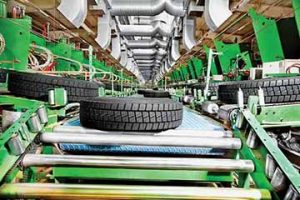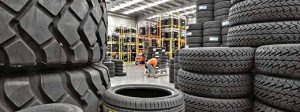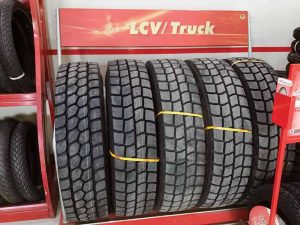Anwesh Koley
Disruptions like axle norms have been instrumental in transforming the nature of CVs in India. They along with the introduction of long standing economic reforms like GST (and e-way bill) are changing the way CV tyres are looked at. Influencing a significant change in CV tyres as challenges like urbanisation, weak market demand and rising TCO come the way of the CV industry, the Truck & Bus (T&B) tyre segments in India are continuing to evolve as an important ancillary. Estimated to generate 55 per cent of the total revenue the Indian tyre industry generates (it is estimated to be worth Rs.53,500 and is expected to reach a topline of Rs.60,000 crore in 2020), the T&B tyre segments are transforming at the OEM and replacement level. Gaining in technology and an ability to respond quickly to market changes, the T&B tyre segments, claimed to contribute around 50 per cent of the total volume in terms of tonnage, are finding themselves in the midst of some far-reaching changes to the Indian automotive sector in the form of BSVI emission norms. Increasing its focus on export markets to insulate against the cyclic nature of the domestic market, the T&B tyre segments are changing in line with the changing concepts of mobility.
Experiencing a rapid evolution of technology, new laws and globally aligned emission norms along with their clients – CV operators and CV makers, the T&B segments, according to Rajiv Prasad, President (India Operations), JK Tyre & Industries Ltd., are gaining in capabilities. This is in-line with the tyre industry enhancing its capabilities and find new ways to grow, he added. Mentioned an industry source that the good performance of the construction and mining segment until some two-to-three months ago, and that of the light and medium-duty segments, the T&B tyre segments have managed to sustain well and grow. Disruptions in the form of raw material prices and availability, technology, market demand, and pricing is influencing the CV tyre makers to look at products and synergies. The products and synergies are leading to higher value and efficiency. They are leading to higher mobility, environment friendliness, safe and sustainable products. Mentioned Prasad, “While growth might not always be robust, there is no denying the fact that a push towards greener, safer and more sustainable products with significant technology infusion are evident.”
Disruptions
New axle norms and the introduction of GST (and the e-way bill) having led to a considerable change, at the CV tyre level, these disruptions are reflecting a change in warranty claims and tyre purchase decisions. With the relatively short replacement cycle for CV tyres keeping the momentum up, it is the factors like weak market demand and liquidity crunch that are expected to exert their influence in the near to medium-term. The slowdown in CV sales expected to take some time to reflect at the replacement level, the infusion of technology at the product, and at the manufacturing level, is helping to address the changing market requirements. With the momentum for CV tyre replacement expected to continue in FY20, the effect of lower fleet utilisation levels is expected to have an effect in the near term. With the elections behind, the demand for some CV segments is expected to keep up over others. As the market sentiment improves, the T&B tyre segments are expected to see a surge in demand at the replacement level if not at the OEM level. Expressed Amit Tolani, Vice President, Marketing, Ceat Limited, mentioned, “The continuity (of the government) at the centre is expected to provide an impetus on infrastructure investments. This would in-turn will help the tyre market to expand considerably in the near future.”
Linked with new business equations such as OEMs cooperating with tyre manufacturers to develop tyres with enhanced friction and weight characteristics, the tyre industry trends are pointing at refined manufacturing processes, higher efficiency and the development of fuel-saving products with lower resistance and higher performance. As regulations like BSVI demand automotive OEMs to turn out CVs that are as efficient and as productive if not more, OEMs are claimed to be seeking the cooperation of aggregate suppliers that include tyre manufacturers to arrive at tyres that have lower rolling resistance and a longer service life. The move to BSVI expected to lead to much product rationalisation, the T&B tyre segments are set to experience a rise in radialisation. The T&B tyre segments are also set to witness a change at the bus level as the business models of operators undergo a significant change. Also, as the nature of buses changes. Growing demand for safety and comfort are ensuring that tyre manufacturers respond with technologically superior products. Products that are a result of a considerable change in the construction and chemical composition; of a considerable change in the manufacturing process. Stating that the per centage of CV radialisation was 48 per cent in FY2018-19 and expected to rise to 70 per cent by FY2023-24, Tolani mentioned that the consciousness for factors like noise and rolling resistance was rising.
With buses expected to lead the government’s initiative for electrification, the T&B tyre segments are up for a considerable change. Future disruptions like the CAFE norms and emission regulations beyond BSVI are certain to alter the cost, performance and efficiency parameters. To lead to far-reaching effects as some SCVs go the petrol route, or are discontinued due to BSVI and safety compliance challenges, the T&B tyre segments are expected to gain in design, development, chemical composition and manufacturing technologies. Averred Prasad, “For a long time now, vehicles across the country have been put to a lot of tests in terms of overloading. These vehicles, as well as the tyres, have been performing well. Regulatory changes like the new axle norm require a slight modification of the current products.” Set to witness a profound change at the tyre design, development and manufacture level, the T&B tyre segments are gain from the tyre manufacturers efforts to build lighter and longer-life tyres. Stating that JK Tyre is developing lighter CV tyres, an industry source on the condition of not revealing his name mentioned that tyre makers are investing in technology and capabilities.
Growing radialisation and R&D initiatives
Increasing its focus on technologically advanced products, JK Tyre has commissioned a modern R&D centre at Chennai. It has enhanced it by investing in an advanced tyre design studio as well. Apollo Tyres is also claimed to invest in capability enhancement as it eyes a prominent global tyre maker position. Queries mailed to the Apollo Tyres spokesperson did not elicit a response until the time of going to press however. With the awareness for radials over bias tyres growing at the operator level, the rate of radialisation is expected to be closely linked with the need to enhance operating efficiency and profitability. Especially in a scenario post BSVI. With CV OEMs looking at products offering the most uptime, comfort, safety, and lowest TCO by employing new technologies like remote diagnostics, the T&B tyre segments are set to gain in form and function. As the Indian auto industry catches up with the advanced markets with BSVI, tyre manufacturers are claimed to make significant Brownfield and Greenfield investments.
What makes the Indian CV tyre scenario interesting is the rising imports. Radial tyre imports are estimated to have grown significantly since FY2013-14. Mentioned a source on the condition of not revealing his name, that the policy to provide deep concession on finished products (tyres) and not on key raw materials like natural rubber is working contrary to the push for local manufacture under the ‘Make in India’ initiative. Tackling gray market imports (mostly from China) are undercutting established brands. They are lacking in certification, and could therefore lack in quality, safety and other parameters. In the face of such happenings, CV tyre manufacturers are continuing to invest in new technologies with an eye on the future. They are identifying core consumer needs using elaborate insight tools. For T&B tyre segments, they are developing new tyres as per the customer demand. Said Tolani, “We are constantly reviewing the changes that are taking place in the CV market place.” Making significant investments in R&D initiatives as well as upgrading their capacities to address the future requirements of CVs (even alternate fuel CVs), tyre manufacturers are looking a significant rise in demand for light and less-friction resistance tyres. Thinking ‘global’, tyre manufacturers are innovating. They are also investing in capacity expansion (largely debt-funded) with a strategy to explore export markets. Mentioned a source that tyre manufacturers continue to look at organic and inorganic ways of growth. By doing so they are looking at strategic enhancements in the area of products, technologies and markets.
Having acquired Tornel, a renowned Mexican company with three plants in the respective country, JK Tyre is claimed to be at the forefront of investing in research and development activities among the Indian tyre majors. Announcing that his company has furthered the cause of research in the tyre segment, Prasad drew attention to the Raghupati Singhania Centre of Excellence (RPSCOE) at Mysore. This centre is researching on material and compound development, on future technologies, computational mechanics, and tyre characterisation, he informed. Emphasising on the semi-anechoic chamber at the facility, Prasad mentioned that it is a first in the Indian tyre industry, and uses specialised software for noise vibration and harshness data analysis. The facility, he added, would help manufacture global-level tyre products that are also fit for the future. Resorting to the higher use of compounds like precipitated silica, which is claimed to cause a significant improvement in fatigue resistance, rolling resistance and heat buildup, tyre manufacturers are working ever more closely with their clients to develop tyres that support higher speeds, payload, performance, efficiency and lower rolling resistance.
Raw materials
A key part of the research and development that tyre manufacturers are indulging in, involves raw materials. It is they that are enabling the tyre industry to address new market requirements like low rolling resistance and light weighting. Experiencing an amount of pressure due to the fluctuation nd availability of raw materials, tyre manufacturers have been tweaking the domestic-to-import mix as well as the synthetic-to-natural rubber mix. This is helping them to optimise costs. Drawing attention to quarterly variation in the domestic-to-import mix, which is linked with the industry’s short-term sourcing, another industry source mentioned that there was a need to gain stability on various parameters. Said Prasad, “Consider the USD exchange rate for example. Tyre manufacturers are often compelled to do much fine balancing.” Revealing that the rising natural rubber and crude prices are affecting product and process costs, Prasad mentioned, “The T&B tyre segments are getting more and more demanding. Customers are increasingly looking for more information on the impact of tyre performance on the vehicles, and how the driving behavior impacts the performance of a tyre.”
Stressing on the need to incorporate new technologies, which will capture all the dynamic parameters like load, inflation, route of operation, tread wear, etc., Tolani mentioned that customers are demanding real-time data. Of the opinion that no one knows the final outcome of parameters such as heat, noise, rolling resistance, friction, etc., Prasad explained that the norms are getting more stringent for domestic and international customers operating in the CV segment. “There was a time when we would not be bothered about tyre noise. Today, noise reduction has become an important parameter for customers,” he added.
Preparing for any disruption that may come their way, tyre manufacturers are enhancing their capabilities. They are doing so with an intention to design products for global markets like Europe, which calls for winter tyres. Accounting for different requirements in different parts of the world, tyre manufacturers are investing in R&D with an ambition to go global. Looking at higher engagement with OEMs, they are expecting a significant rise in OEM sales. Estimated to export in excess of 87 per cent of the tyres it produces, BKT Tyres is setting an example of how Indian tyre makers can go global, mentioned a source. Another example, he said, is Apollo Tyres. The tyre major has invested in a plant at Hungary to supply PV as well as CV tyres in Europe and the surrounding markets.
The unorganised market
The unorganised market in India is posing a challenge to tyre majors like MRF, Apollo Tyres and JK Tyre. It offers cheaper, imported tyres sourced from China mostly. Often non-certified (tyres in India carry ISI certification), these tyres may not be of the same quality that the Indian manufacturers offer, They could thus pose a safety hazard and lead to higher TCO by providing less mileage. Having limited their ingress by levying an anti-dumping duty, the government, the tyre industry is expecting, should do more to support their growth. Stated Prasad, “Everyone is protecting their market. Especially with respect to China and other low-cost countries.” There is a need for our market to be well-protected in the interest of the growth of the local industry, he concluded.


























